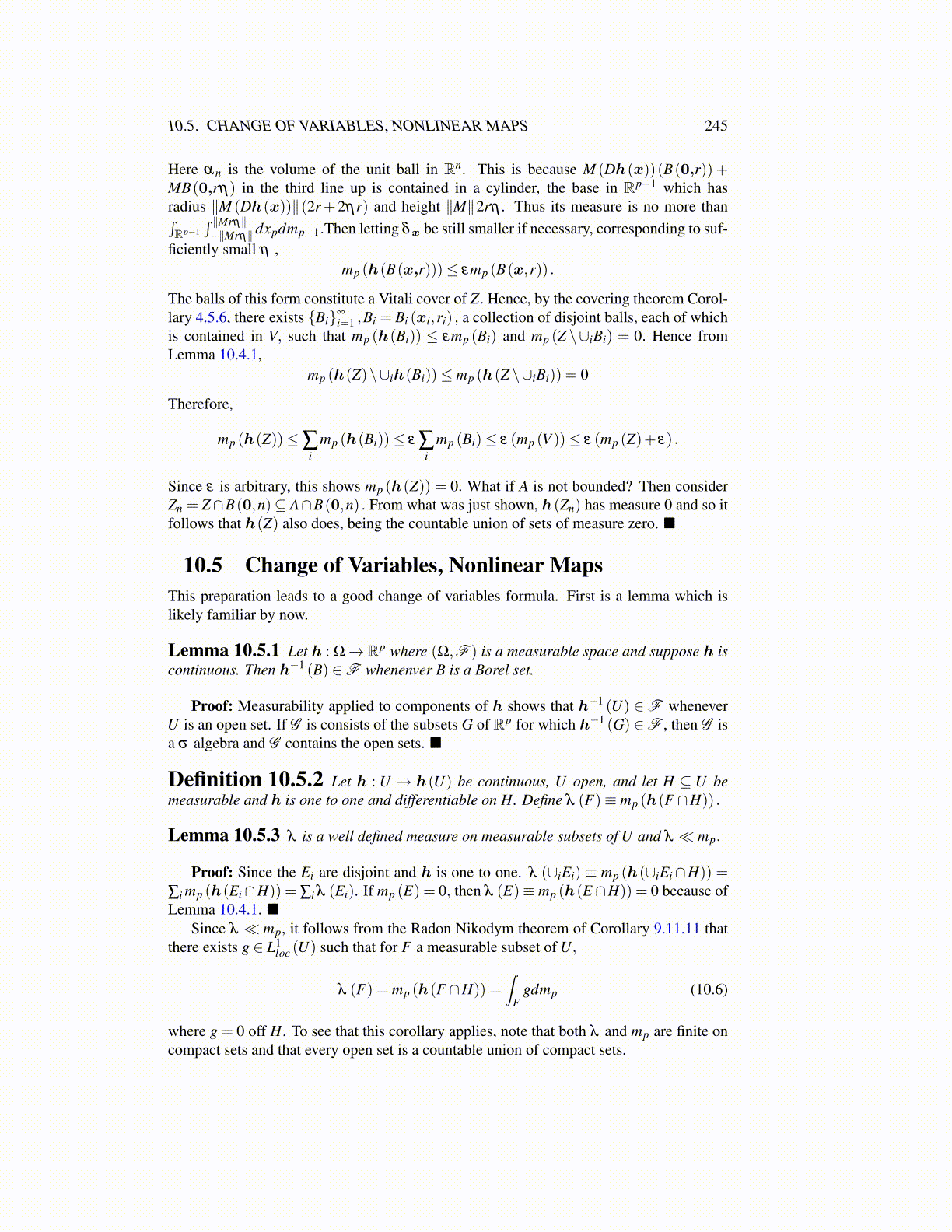
10.5. CHANGE OF VARIABLES, NONLINEAR MAPS 245
Here αn is the volume of the unit ball in Rn. This is because M (Dh(x))(B(0,r)) +MB(0,rη) in the third line up is contained in a cylinder, the base in Rp−1 which hasradius ∥M (Dh(x))∥(2r+2ηr) and height ∥M∥2rη . Thus its measure is no more than∫Rp−1
∫ ∥Mrη∥−∥Mrη∥ dxpdmp−1.Then letting δx be still smaller if necessary, corresponding to suf-
ficiently small η ,mp (h(B(x,r)))≤ εmp (B(x,r)) .
The balls of this form constitute a Vitali cover of Z. Hence, by the covering theorem Corol-lary 4.5.6, there exists {Bi}∞
i=1 ,Bi = Bi (xi,ri) , a collection of disjoint balls, each of whichis contained in V, such that mp (h(Bi)) ≤ εmp (Bi) and mp (Z \∪iBi) = 0. Hence fromLemma 10.4.1,
mp (h(Z)\∪ih(Bi))≤ mp (h(Z \∪iBi)) = 0
Therefore,
mp (h(Z))≤∑i
mp (h(Bi))≤ ε ∑i
mp (Bi)≤ ε (mp (V ))≤ ε (mp (Z)+ ε) .
Since ε is arbitrary, this shows mp (h(Z)) = 0. What if A is not bounded? Then considerZn = Z∩B(0,n)⊆ A∩B(0,n) . From what was just shown, h(Zn) has measure 0 and so itfollows that h(Z) also does, being the countable union of sets of measure zero. ■
10.5 Change of Variables, Nonlinear MapsThis preparation leads to a good change of variables formula. First is a lemma which islikely familiar by now.
Lemma 10.5.1 Let h : Ω→ Rp where (Ω,F ) is a measurable space and suppose h iscontinuous. Then h−1 (B) ∈F whenenver B is a Borel set.
Proof: Measurability applied to components of h shows that h−1 (U) ∈F wheneverU is an open set. If G is consists of the subsets G of Rp for which h−1 (G) ∈F , then G isa σ algebra and G contains the open sets. ■
Definition 10.5.2 Let h : U → h(U) be continuous, U open, and let H ⊆ U bemeasurable and h is one to one and differentiable on H. Define λ (F)≡ mp (h(F ∩H)) .
Lemma 10.5.3 λ is a well defined measure on measurable subsets of U and λ ≪ mp.
Proof: Since the Ei are disjoint and h is one to one. λ (∪iEi) ≡ mp (h(∪iEi∩H)) =
∑i mp (h(Ei∩H)) = ∑i λ (Ei). If mp (E) = 0, then λ (E)≡mp (h(E ∩H)) = 0 because ofLemma 10.4.1. ■
Since λ ≪ mp, it follows from the Radon Nikodym theorem of Corollary 9.11.11 thatthere exists g ∈ L1
loc (U) such that for F a measurable subset of U,
λ (F) = mp (h(F ∩H)) =∫
Fgdmp (10.6)
where g = 0 off H. To see that this corollary applies, note that both λ and mp are finite oncompact sets and that every open set is a countable union of compact sets.